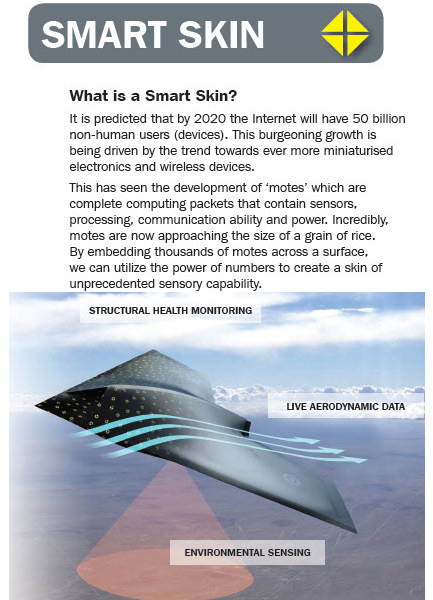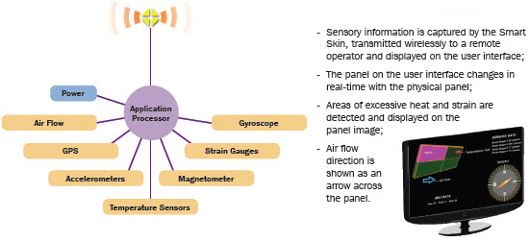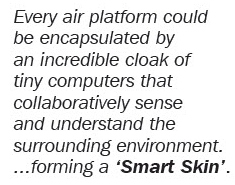 |
| November 04, 2014 | Volume 10 Issue 41 |
Designfax weekly eMagazine
Archives
Partners
Manufacturing Center
Product Spotlight
Modern Applications News
Metalworking Ideas For
Today's Job Shops
Tooling and Production
Strategies for large
metalworking plants
Wings:
Engineers developing smart skin to detect aircraft injury

Work is underway at BAE Systems to give aircraft human-like "skin," enabling the detection of injury or damage and the ability to "feel" the world around them.
Engineers at BAE's Advanced Technology Centre (Essex, U.K.) are investigating a "smart skin" concept that could be embedded with tens of thousands of micro-sensors. When applied to an aircraft, this will enable it to sense wind speed, temperature, physical strain, and movement far more accurately than current sensor technology allows.
The revolutionary smart skin concept will enable aircraft to continually monitor their health, reporting back on potential problems before they become significant. This would reduce the need for regular check-ups on the ground, and parts could be replaced in a timely manner -- increasing the efficiency of aircraft maintenance, the availability of the plane, and improving safety.

These tiny sensors or "motes" can be as small as grains of rice and even as small as dust particles at less than 1 mm2. Collectively, the sensors would have their own power source and, when paired with the appropriate software, be able to communicate in much the same way that human skin sends signals to the brain. The sensors are so small that BAE engineers are exploring the possibility of retrofitting them to existing aircraft and even spraying them on like paint.
Leading the research and development is Senior Research Scientist Lydia Hyde, whose eureka moment came when she was doing her laundry and observed that her tumble dryer uses a sensor to prevent it from overheating.

Lydia said: "Observing how a simple sensor can be used to stop a domestic appliance overheating got me thinking about how this could be applied to my work and how we could replace bulky, expensive sensors with cheap, miniature, multi-functional ones. This, in turn, led to the idea that aircraft, or indeed cars and ships, could be covered by thousands of these motes creating a smart skin that can sense the world around them and monitor their condition by detecting stress, heat, or damage. The idea is to make platforms "feel" using a skin of sensors in the same way humans or animals do.
"By combining the outputs of thousands of sensors with big data analysis, the technology has the potential to be a game-changer for the [aircraft] industry. In the future, we could see more robust defense platforms that are capable of more complex missions whilst reducing the need for routine maintenance checks. There are also wider civilian applications for the concept which we are exploring."
This research is part of a range of new systems that BAE engineers are investigating under a major program exploring next-generation technology for air platforms.
Source: BAE Systems
Published November 2014
Rate this article
View our terms of use and privacy policy
